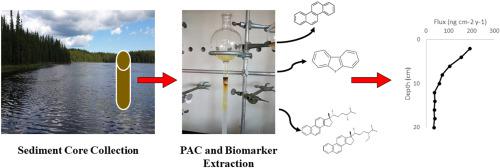Environmental Pollution ( IF 8.9 ) Pub Date : 2020-11-24 , DOI: 10.1016/j.envpol.2020.116060 Alexandre P.J. Salat , David C. Eickmeyer , Linda E. Kimpe , Roland I. Hall , Brent B. Wolfe , Lukas J. Mundy , Vance L. Trudeau , Jules M. Blais

|
We examined polycyclic aromatic compounds (PACs) and petroleum biomarkers (steranes, hopanes, and terpanes) in radiometrically-dated lake sediment cores from the Athabasca oil sands region (AOSR) and the Peace-Athabasca Delta (PAD) region in Alberta (Canada) to determine whether contributions from petroleum hydrocarbons have changed over time. Two floodplain lakes in the PAD (PAD 30, PAD 31) recorded increased flux of alkylated PACs and increased petrogenic (petroleum-derived) hydrocarbons after ∼1980, coincident with a decline of sediment organic carbon content and a rise of bulk sedimentation rate, likely due to increased Athabasca River flow. A large expansion of upstream oilsands mining, upgrading, and refining may also have contributed to the observed shift to more petrogenic hydrocarbons to sediments since the 1980s. Alkylated PAC flux increased in the floodplain lake analyzed within the AOSR (Saline Lake) since the 1970s-1980s, coincident with a sharp rise in sediment organic carbon content and increased contributions of petrogenic hydrocarbons. These changes identify increased supply of petrogenic PACs occurred as Athabasca River floodwaters waned, and may implicate aerial contributions of petrogenic hydrocarbons from oilsands activity. PACs and petroleum biomarkers (steranes, hopanes, and terpanes) in sediment cores from Saline Lake, PAD 30 and PAD 31 revealed a predominance of petrogenic hydrocarbons in these lakes. In contrast, we recorded minimal petrogenic hydrocarbons in the reference lakes outside the surface minable area of the AOSR and PAD (Mariana Lake and BM11), though we noted slight increases in petrogenic contributions to modern (2010-2016) sediments. We show how a combined analysis of PACs and petroleum biomarkers in sediments is useful to quantify petrogenic contributions to lakes with added confidence and highlight the potential for petroleum biomarkers in lake sediment cores as a novel and effective method to track petroleum hydrocarbons in lake sediment.
中文翻译:

油砂地区湖泊沉积物岩心中石油生物标志物和多环芳族化合物的综合分析
我们检查了来自加拿大艾伯塔省阿萨巴斯卡油砂地区(AOSR)和和平阿萨巴斯卡三角洲(PAD)地区辐射定年的湖沉积岩心中的多环芳族化合物(PACs)和石油生物标记物(甾烷,hop烷和萜烯)确定石油碳氢化合物的贡献是否随时间变化。PAD的两个洪泛区湖泊(PAD 30,PAD 31)记录了1980年前后烷基化PAC的通量增加和成岩(石油衍生的)碳氢化合物的增加,这与沉积物有机碳含量下降和整体沉积速率上升相一致。由于阿萨巴斯卡河流量增加。自1980年代以来,上游油砂的大规模扩张,开采,提炼和精炼也可能促使人们观察到将更多的成岩碳氢化合物转移到沉积物中。自1970年代至1980年代以来,AOSR(盐湖)中的泛滥湖中的烷基化PAC通量增加,这与沉积物中有机碳含量的急剧上升和成岩烃的贡献增加相吻合。这些变化确定了随着阿萨巴斯卡河洪水消退而发生的成岩PAC的供应增加,并且可能暗示了油砂活动对生烃的空中贡献。盐湖,PAD 30和PAD 31沉积物中的PAC中的PAC和石油生物标志物(甾烷,pan烷和萜烯)显示出这些湖中大量的成烃。相比之下,我们在AOSR和PAD(马里亚纳湖和BM11)地表可开采区域之外的参考湖中记录了最小的成岩烃,尽管我们注意到成因对现代(2010-2016年)沉积物的贡献略有增加。我们展示了如何对沉积物中的PACs和石油生物标记物进行综合分析如何以增加的置信度来量化对湖泊的岩石成因,并突出显示湖底沉积物岩芯中石油生物标记物作为追踪湖底沉积物中石油碳氢化合物的新型有效方法的潜力。


























 京公网安备 11010802027423号
京公网安备 11010802027423号